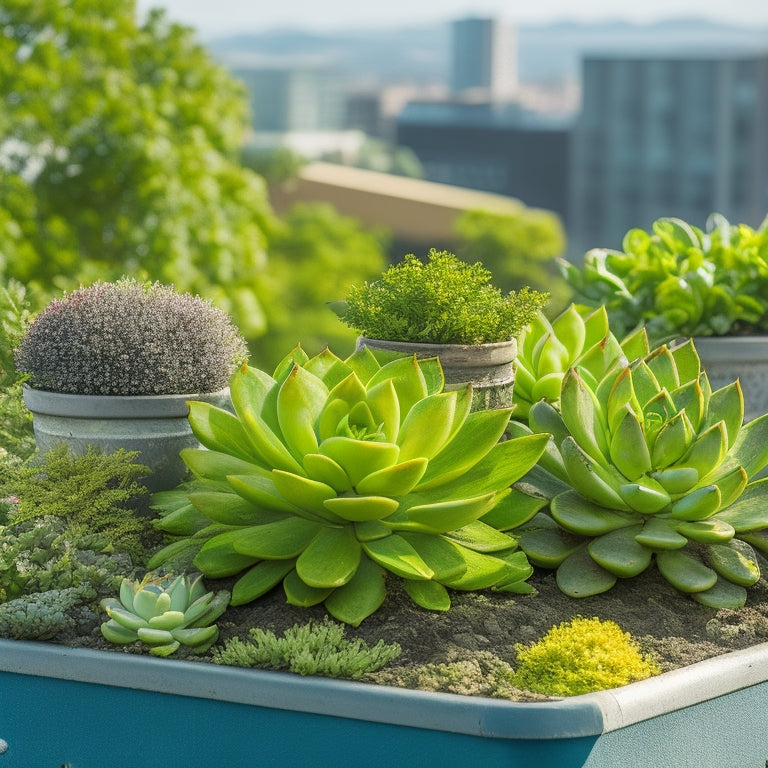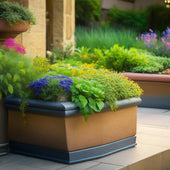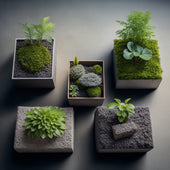
What Plants Thrive in Urban Rooftop Containers?
Share
You'll find that succulents like sedum and yucca, as well as flowering plants like petunias and daisies, thrive in urban rooftop containers. Herbs like basil and rosemary also do well in warm conditions, while trailing plants like creeping Jenny and sweet alyssum excel in hanging baskets. For shade and partial sun, consider ferns, impatiens, and coleus. Drought-tolerant plants like sedum and yarrow help conserve water, and air-purifying plants like spider plants and peace lilies improve indoor air quality. When choosing plants, consider factors like temperature tolerance, sunlight needs, and soil quality to guarantee they'll flourish in your rooftop container.
Key Takeaways
• Choose plants tolerant of extreme temperatures, intense sunlight, and poor soil quality for urban rooftop containers.
• Select native or adapted species for urban microclimates, such as succulents and drought-tolerant plants like sedum and yucca.
• Consider flowering plants like petunias, daisies, and begonias that thrive in rooftop conditions and provide vibrant color.
• Herbs like basil, mint, and cilantro are excellent choices for urban rooftop containers, as they are easy to care for and provide fresh flavors.
• Trailing plants like creeping Jenny and sweet alyssum are ideal for hanging baskets, adding a decorative touch to urban rooftop spaces.
Choosing the Right Container Size
When selecting rooftop containers, evaluate the mature size of the plant and the available space to confirm you're choosing a container that's large enough to accommodate the plant's growth while fitting comfortably on your rooftop. This is vital to guarantee the plant receives adequate room to spread its roots and grow, preventing it from becoming pot-bound.
You'll also want to assess the weight of the container when it's fully saturated with water and soil, as this will impact the structural integrity of your rooftop.
Choose container materials that are durable, weather-resistant, and able to withstand extreme temperatures. Reflect on materials like fiberglass, polypropylene, or ceramic, which offer excellent durability and resistance to UV degradation.
Additionally, look for containers with built-in drainage solutions, such as holes or a built-in water reservoir, to prevent waterlogged soil and root rot. Proper drainage is essential for healthy plant growth and preventing water damage to your rooftop.
Selecting Plants for Urban Conditions
When selecting plants for your urban rooftop container, you'll want to prioritize species that can thrive in harsh urban conditions.
You're looking for plants that can handle extreme temperatures, intense sunlight, and winds that can be fierce on high-rise rooftops.
Urban Heat Tolerance
Selecting plants that thrive in urban heat requires considering species tolerant of high temperatures, intense sunlight, and dry air, as rooftop containers often experience microclimates with extreme conditions.
You'll want to choose plants that can withstand heat stress, which occurs when plants are exposed to temperatures above their ideal range. This can lead to wilting, scorching, and even plant death.
When selecting plants for urban rooftop containers, look for species that are native to warm, dry regions or have adapted to urban microclimates.
Succulents and drought-tolerant plants like sedum, yucca, and cacti are excellent choices. They've developed strategies to conserve water and protect themselves from intense sunlight.
Other heat-tolerant plants include herbs like basil and rosemary, which can thrive in warm conditions with minimal watering.
Wind and Sun Exposure
You'll need plants that can withstand the intense sunlight and fierce winds that often characterize urban rooftop containers. To guarantee their survival, select plants with built-in defense mechanisms against harsh weather conditions.
For instance, succulents and cacti have thick, waxy leaves that conserve water and protect them from drying winds. Additionally, consider plants with a natural ability to adapt to strong sunlight, such as those with silver or grey leaves that reflect sun rays.
To further mitigate the effects of wind and sun, incorporate wind barriers and sun reflection strategies into your container design. Place plants in a location that provides some shelter from prevailing winds or create a windbreak using trellises or screens.
You can also use light-colored mulch or gravel to reflect sun rays and reduce heat absorption. Remember, plants in urban rooftop containers are more vulnerable to extreme weather conditions, so it's essential to choose resilient species and design your container with safety in mind.
Soil Quality Matters
Most urban rooftop containers are filled with soil that lacks essential nutrients and organic matter, so it's crucial to choose plants that can thrive in these conditions.
You'll want to select plants that are tolerant of poor soil quality or can benefit from soil amendments. As you prepare your rooftop container, consider adding organic matter like compost or well-rotted manure to improve soil structure and fertility.
If your container lacks proper drainage, you'll need to incorporate drainage solutions, such as a layer of perlite or vermiculite, to prevent waterlogged soil.
When selecting plants, look for those that are adapted to urban conditions, such as succulents or drought-tolerant species. These plants will be more resistant to soil-borne diseases and pests, reducing the need for pesticides and other chemicals.
Succulents for Low Maintenance
When selecting succulents for your urban rooftop container, you'll want to focus on drought-tolerant species that can thrive in harsh conditions.
You'll appreciate the ease of watering schedules, as these plants can survive with infrequent watering, and some can even go weeks without a drink.
Drought Tolerant Species
Succulents, with their ability to store water in their leaves, stems, or roots, thrive in urban rooftop containers, providing a low-maintenance option for city dwellers. You'll appreciate their hardiness, especially during native droughts, when water scarcity is a concern. By choosing succulents, you're adopting xeriscape gardening principles, which prioritize water efficiency and sustainable practices.
When selecting drought-tolerant species, consider Echeveria, Crassula, and Sedum. These succulents have adapted to survive in dry conditions, making them perfect for urban rooftop containers. They require minimal watering, reducing the risk of overwatering and associated safety hazards, like slippery roofs or structural damage.
As you design your rooftop garden, remember to group succulents according to their watering needs. This will guarantee you're not overwatering some plants while underwatering others. With proper care, succulents will flourish, providing a beautiful, low-maintenance oasis in the midst of the bustling city.
Easy Watering Schedules
You can establish an easy watering schedule by watering your rooftop succulents every 7-10 days during spring and summer, and every 4-6 weeks during fall and winter, allowing the soil to dry out completely between waterings.
This schedule guarantees your plants receive the right amount of moisture without overwatering, which can lead to root rot and other problems.
To make watering even easier, consider installing a drip irrigation system, which delivers water directly to the roots, reducing evaporation and runoff.
Additionally, use a well-draining potting mix with high moisture retention to help your succulents survive between waterings.
By following this schedule and using the right materials, you'll be able to enjoy thriving succulents on your rooftop without worrying about frequent watering.
Remember to monitor the weather and adjust your watering schedule accordingly.
In hot, dry spells, you may need to water more frequently, while cool, rainy periods may require less watering.
With a little planning and attention, you'll be able to create a low-maintenance rooftop oasis that brings joy and beauty to your urban space.
Hardy Temperature Ranges
Most rooftop succulent species thrive in temperatures between 40°F and 90°F (4°C and 32°C), making them ideal for urban containers that experience varying temperature fluctuations.
You don't need to worry about extreme temperature ranges, as succulents are adapted to survive in conditions with minimal maintenance. They can tolerate temperature extremes, from scorching summers to chilly winters, without requiring constant monitoring.
As you plan your urban rooftop container garden, consider the seasonal variations in your area. Succulents can thrive in areas with mild winters and hot summers, as well as regions with cold winters and cool summers.
They're perfect for rooftop containers that receive direct sunlight, partial shade, or even full shade. With succulents, you can rest assured that your plants will survive and even flourish in urban environments.
Flowering Plants for Colorful Displays
Vibrant flowering plants can transform your urban rooftop container into a stunning visual display, adding a pop of color and beauty to your outdoor space.
When selecting flowering plants, consider flowering perennials that will bloom year after year, or seasonal blooms that will provide a burst of color during a specific time of year.
Here are 4 flowering plants that thrive in urban rooftop containers:
-
Petunias: These colorful annuals come in a variety of shapes and sizes, and can trail down the sides of your container or grow upright.
-
Daisies: With their bright white petals and yellow centers, daisies are a classic choice for adding a touch of whimsy to your rooftop container.
-
Begonias: These flowering perennials come in a range of colors, including pink, white, and red, and can tolerate partial shade.
- Marigolds: With their bright orange and yellow blooms, marigolds are a great choice for adding a pop of color to your rooftop container.
Remember to choose plants that are suitable for your rooftop's climate and level of sunlight.
Don't forget to water and fertilize them regularly to keep them healthy and thriving.
Herbs for Urban Rooftop Cooking
Fresh herbs grown in urban rooftop containers can elevate your cooking by providing immediate access to fragrant, flavorful ingredients that can be snipped and added to a variety of dishes at a moment's notice.
When choosing cooking herbs for your rooftop container, consider the amount of sunlight your space receives and select herbs that thrive in those conditions. Basil, mint, and cilantro prefer full sun, while parsley, chamomile, and lemon balm do well in partial shade.
Make certain your herb containers have good drainage to prevent waterlogged soil, which can lead to root rot and other problems. Use a well-draining potting mix and a container with built-in drainage holes to guarantee healthy root growth.
You can also group herbs with similar growing conditions together in the same container to simplify care. By following these tips, you'll be enjoying fresh, fragrant herbs in no time, and taking your cooking to the next level.
Trailing Plants for Hanging Baskets
You can add visual interest to your urban rooftop space by incorporating trailing plants in hanging baskets, which can cascade down and create a lush, verdant display. This is especially effective when combined with other container plants, as the trailing vines can spill over the edges and create a sense of movement.
When choosing plants for hanging baskets, consider the following options:
-
Creeping Jenny (Lysimachia nummularia 'Aurea'): A fast-growing, golden-leaved plant that can trail up to 3 feet.
-
Sweet Alyssum (Lobularia maritima): A tiny, white-flowering plant that cascades beautifully and attracts pollinators.
-
Trailing Verbena (Verbena x hybrida): A low-maintenance option with small, fragrant flowers in shades of pink, purple, and white.
- Boston Ivy (English Ivy, Hedera helix): An evergreen climber with small, white flowers in fall and attractive foliage year-round.
Remember to choose plants that thrive in your local climate and provide the necessary care, such as watering and fertilization, to guarantee their success.
Plants for Shade and Partial Sun
When designing your urban rooftop container garden, consider incorporating plants that thrive in shade and partial sun, as these areas often receive limited direct sunlight. Shade loving plants are perfect for areas that receive indirect sunlight or are shaded by neighboring buildings. These plants are adapted to survive with minimal light and can add beauty and texture to your rooftop garden.
Some excellent shade loving plants for your urban rooftop container garden include ferns, impatiens, and coleus. These plants are low maintenance, easy to care for, and can thrive in containers with good drainage. You can create stunning container plant combinations by pairing these shade loving plants with flowering plants like begonias or geraniums.
Remember to choose plants that have similar growing conditions and light requirements to guarantee they thrive in your rooftop garden.
Also, make sure to select containers with good drainage holes to prevent waterlogged soil, which can be detrimental to plant health.
Drought-Tolerant Plants for Water Efficiency
Since rooftop gardens often face water restrictions, incorporating drought-tolerant plants into your design can greatly reduce water consumption and maintenance needs. This approach also aligns with xeriscaping techniques, which prioritize water efficiency. By choosing native drought-tolerant plants, you'll not only conserve water but also create a low-maintenance and sustainable rooftop garden.
Here are some top picks for drought-tolerant plants that thrive in urban rooftop containers:
-
Sedum: A succulent that stores water in its leaves, making it perfect for hot and dry conditions.
-
Yarrow: A low-maintenance perennial that requires minimal watering and care.
-
Lavender: A fragrant, low-water herb that attracts pollinators and adds a touch of elegance to your rooftop garden.
- Cacti: A variety of species that come in different shapes and sizes, all of which are adapted to survive with minimal water.
Air-Purifying Plants for Urban Spaces
Urban rooftop containers can greatly benefit from incorporating air-purifying plants, which effectively remove pollutants and toxins from the air, thereby improving indoor air quality.
You'll be surprised at the air purifying benefits these plants provide, making them a great addition to your urban space. By incorporating plants like Spider Plants, Peace Lilies, or Dracaena into your rooftop container, you'll be able to breathe easier knowing the air you're breathing is cleaner.
These plants are natural air filters, removing pollutants like formaldehyde, benzene, and trichloroethylene from the air. This is especially important in urban areas where air quality can be poor.
By choosing the right air-purifying plants, you can improve the indoor air quality of your rooftop space, creating a healthier environment for you and your family.
Frequently Asked Questions
How Often Should I Fertilize Urban Rooftop Container Plants?
You should fertilize urban rooftop container plants every 1-2 weeks during the growing season, using balanced, water-soluble fertilizers applied through foliar sprays or soil drenches, ensuring not to over-fertilize and risking plant damage.
Can I Grow Plants in Rooftop Containers With No Drainage?
"You're walking on thin ice without drainage, but don't get frozen out - consider implementing drainage solutions like raised beds or built-in drainage holes in your rooftop containers, ensuring a minimum container depth of 5-7 inches to prevent waterlogged soil."
Will Strong Winds Damage Urban Rooftop Container Plants?
You'll need to guarantee wind resistance by securing containers with weights or anchors, and prioritize container stability by using wide bases, low centers of gravity, and flexible materials to prevent toppling and damage in strong winds.
How Do I Protect Rooftop Plants From Extreme Temperatures?
To protect your rooftop plants from extreme temperatures, you'll want to implement shade solutions, like umbrellas or shade cloth, and prioritize temperature regulation using insulation, thermal mass, or heating/cooling systems to maintain a stable environment.
Are Urban Rooftop Container Plants Susceptible to Pests?
As you bask in the rooftop oasis, don't let pests crash the party! You'll need to stay vigilant with pest management, opting for organic solutions like neem oil and introducing beneficial insects to keep unwanted critters at bay.
Related Posts
-

3 Best Tool Essentials for Creative Concrete Planters
To create visually stunning and durable concrete planters, you'll need three essential tool categories. First, you'll...
-

3 Best Tool Essentials for Creative Concrete Planters
To create visually stunning and durable concrete planters, you'll need three essential tool categories. First, you'll...
-

3 Best Tool Essentials for Creative Concrete Planters
To create visually stunning and durable concrete planters, you'll need three essential tool categories. First, you'll...
-

3 Best Tool Essentials for Creative Concrete Planters
To create visually stunning and durable concrete planters, you'll need three essential tool categories. First, you'll...
-

3 Best Tool Essentials for Creative Concrete Planters
To create visually stunning and durable concrete planters, you'll need three essential tool categories. First, you'll...
-

3 Best Tool Essentials for Creative Concrete Planters
To create visually stunning and durable concrete planters, you'll need three essential tool categories. First, you'll...
-

3 Best Tool Essentials for Creative Concrete Planters
To create visually stunning and durable concrete planters, you'll need three essential tool categories. First, you'll...
-

3 Best Tool Essentials for Creative Concrete Planters
To create visually stunning and durable concrete planters, you'll need three essential tool categories. First, you'll...
-

3 Best Tool Essentials for Creative Concrete Planters
To create visually stunning and durable concrete planters, you'll need three essential tool categories. First, you'll...
-

3 Best Tool Essentials for Creative Concrete Planters
To create visually stunning and durable concrete planters, you'll need three essential tool categories. First, you'll...
-

3 Best Tool Essentials for Creative Concrete Planters
To create visually stunning and durable concrete planters, you'll need three essential tool categories. First, you'll...
-

3 Best Tool Essentials for Creative Concrete Planters
To create visually stunning and durable concrete planters, you'll need three essential tool categories. First, you'll...
-

3 Best Tool Essentials for Creative Concrete Planters
To create visually stunning and durable concrete planters, you'll need three essential tool categories. First, you'll...
-

3 Best Tool Essentials for Creative Concrete Planters
To create visually stunning and durable concrete planters, you'll need three essential tool categories. First, you'll...
-

5 Essential Drainage Tips for Block Planters
When using block planters, you'll want to guarantee effective drainage to prevent waterlogging and root rot. Start by...
-

5 Essential Drainage Tips for Block Planters
When using block planters, you'll want to guarantee effective drainage to prevent waterlogging and root rot. Start by...
-

5 Essential Drainage Tips for Block Planters
When using block planters, you'll want to guarantee effective drainage to prevent waterlogging and root rot. Start by...
-

5 Essential Drainage Tips for Block Planters
When using block planters, you'll want to guarantee effective drainage to prevent waterlogging and root rot. Start by...
-

5 Essential Drainage Tips for Block Planters
When using block planters, you'll want to guarantee effective drainage to prevent waterlogging and root rot. Start by...
-

5 Essential Drainage Tips for Block Planters
When using block planters, you'll want to guarantee effective drainage to prevent waterlogging and root rot. Start by...
-

5 Essential Drainage Tips for Block Planters
When using block planters, you'll want to guarantee effective drainage to prevent waterlogging and root rot. Start by...
-

5 Essential Drainage Tips for Block Planters
When using block planters, you'll want to guarantee effective drainage to prevent waterlogging and root rot. Start by...
-

5 Essential Drainage Tips for Block Planters
When using block planters, you'll want to guarantee effective drainage to prevent waterlogging and root rot. Start by...
-

5 Essential Drainage Tips for Block Planters
When using block planters, you'll want to guarantee effective drainage to prevent waterlogging and root rot. Start by...
-

5 Essential Drainage Tips for Block Planters
When using block planters, you'll want to guarantee effective drainage to prevent waterlogging and root rot. Start by...
-

5 Essential Drainage Tips for Block Planters
When using block planters, you'll want to guarantee effective drainage to prevent waterlogging and root rot. Start by...
-

5 Essential Drainage Tips for Block Planters
When using block planters, you'll want to guarantee effective drainage to prevent waterlogging and root rot. Start by...
-

5 Essential Drainage Tips for Block Planters
When using block planters, you'll want to guarantee effective drainage to prevent waterlogging and root rot. Start by...
-

5 Essential Drainage Tips for Block Planters
When using block planters, you'll want to guarantee effective drainage to prevent waterlogging and root rot. Start by...
-

5 Essential Drainage Tips for Block Planters
When using block planters, you'll want to guarantee effective drainage to prevent waterlogging and root rot. Start by...
-

5 Essential Drainage Tips for Block Planters
When using block planters, you'll want to guarantee effective drainage to prevent waterlogging and root rot. Start by...
-

5 Essential Drainage Tips for Block Planters
When using block planters, you'll want to guarantee effective drainage to prevent waterlogging and root rot. Start by...
-

Why Choose the Right Blocks for Your Planters
When creating a thriving planter, you need to choose the right blocks to support the entire ecosystem. Start by evalu...
-

Why Choose the Right Blocks for Your Planters
When creating a thriving planter, you need to choose the right blocks to support the entire ecosystem. Start by evalu...
-

Why Choose the Right Blocks for Your Planters
When creating a thriving planter, you need to choose the right blocks to support the entire ecosystem. Start by evalu...
-

Why Choose the Right Blocks for Your Planters
When creating a thriving planter, you need to choose the right blocks to support the entire ecosystem. Start by evalu...
-

Why Choose the Right Blocks for Your Planters
When creating a thriving planter, you need to choose the right blocks to support the entire ecosystem. Start by evalu...
-

Why Choose the Right Blocks for Your Planters
When creating a thriving planter, you need to choose the right blocks to support the entire ecosystem. Start by evalu...
-

Why Choose the Right Blocks for Your Planters
When creating a thriving planter, you need to choose the right blocks to support the entire ecosystem. Start by evalu...
-

Why Choose the Right Blocks for Your Planters
When creating a thriving planter, you need to choose the right blocks to support the entire ecosystem. Start by evalu...
-

Why Choose the Right Blocks for Your Planters
When creating a thriving planter, you need to choose the right blocks to support the entire ecosystem. Start by evalu...
-

Why Choose the Right Blocks for Your Planters
When creating a thriving planter, you need to choose the right blocks to support the entire ecosystem. Start by evalu...
-

Why Choose the Right Blocks for Your Planters
When creating a thriving planter, you need to choose the right blocks to support the entire ecosystem. Start by evalu...
-

Why Choose the Right Blocks for Your Planters
When creating a thriving planter, you need to choose the right blocks to support the entire ecosystem. Start by evalu...
-

Why Choose the Right Blocks for Your Planters
When creating a thriving planter, you need to choose the right blocks to support the entire ecosystem. Start by evalu...
-

Why Choose the Right Blocks for Your Planters
When creating a thriving planter, you need to choose the right blocks to support the entire ecosystem. Start by evalu...
-

Why Choose the Right Blocks for Your Planters
When creating a thriving planter, you need to choose the right blocks to support the entire ecosystem. Start by evalu...
-

Why Choose the Right Blocks for Your Planters
When creating a thriving planter, you need to choose the right blocks to support the entire ecosystem. Start by evalu...
-

Why Choose the Right Blocks for Your Planters
When creating a thriving planter, you need to choose the right blocks to support the entire ecosystem. Start by evalu...
-

Why Choose the Right Blocks for Your Planters
When creating a thriving planter, you need to choose the right blocks to support the entire ecosystem. Start by evalu...
-

Why Choose the Right Blocks for Your Planters
When creating a thriving planter, you need to choose the right blocks to support the entire ecosystem. Start by evalu...
-

Why Choose the Right Blocks for Your Planters
When creating a thriving planter, you need to choose the right blocks to support the entire ecosystem. Start by evalu...
-

Why Choose the Right Blocks for Your Planters
When creating a thriving planter, you need to choose the right blocks to support the entire ecosystem. Start by evalu...
-

Why Choose the Right Blocks for Your Planters
When creating a thriving planter, you need to choose the right blocks to support the entire ecosystem. Start by evalu...
-

Why Choose the Right Blocks for Your Planters
When creating a thriving planter, you need to choose the right blocks to support the entire ecosystem. Start by evalu...


